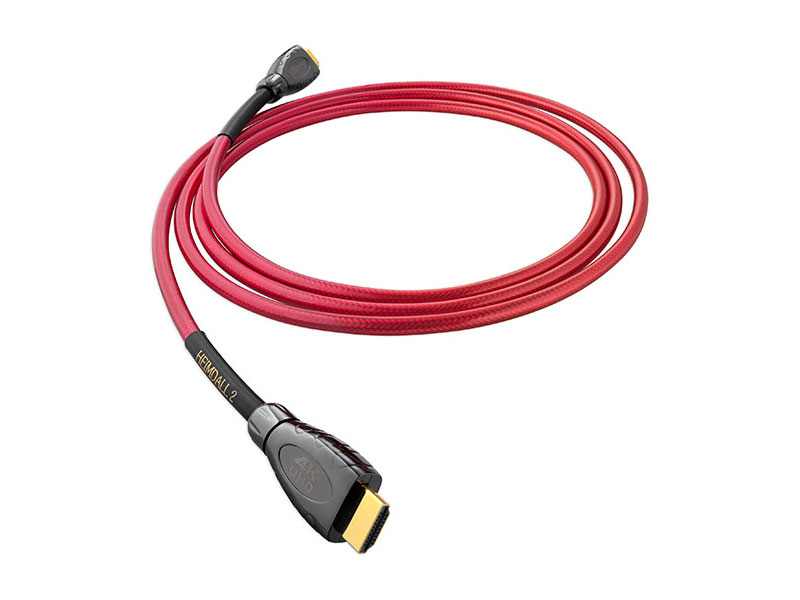Hi-Fi Video: Nordost's Heimdall 2 4K UHD Cable
hrough the first twenty years of my life, the greatest change in entertainment technology was the switch from over-the-air TV -- with its grand total of four channels -- to cable, which bestowed all of 24 channels, some from exotic, faraway places like Atlanta and Chicago. Contrast this state of affairs with today, when A/V technology, which overlaps with cellular communications and computers, seems to change every few months. The new standard in video display technology, 4K Ultra High Definition (UHD), has already arrived on the heels of full HD, putting consumers in the midst of a game of hurry-up-and-wait. Content for new 4K TVs lags behind the standard itself, making it something of a lost soul in the technology landscape: better but almost unusable today. There is no UHD physical format, and native 4K programming is rare. Compatible TVs are available, and their ability to upsample HD content is what has driven sales, such as they are.
All of this provides context for Nordost's newest A/V cables, the Heimdall 2 (top, $599.99), which I've been using, and the Valhalla 2 ($2999.99). Before providing any discussion of performance, however, I need to revisit what I wrote in a blog on Nordost's Blue Heaven HDMI cable, specifically the company's unorthodox method for bringing an HDMI cable to market. Nordost makes all of its HDMI cables in-house, choosing this over having them manufactured in China, which is the case for every other HDMI cable extant. This is far more complicated than it may seem, owing to HDMI itself. HDMI is actually a set of rules, not a generic name for a cable. These rules encompass digital audio and video transmission, Ethernet connectivity, power and control of interconnected electronics -- a vast array of different needs, along with specifications for impedance and termination. Look inside an HDMI connector and you'll see just how many connection points there are, each corresponding to conductors within the cable itself. As with its Blue Heaven HDMI cable, Nordost leaned on the expertise of Jeffrey Boccaccio, author of HDMI Uncensored. Boccaccio was Nordost's technical advisor for the Blue Heaven HDMI project, and he has reprised his role here. His DPL Lab tested the new 4K UHD cables prior to their release to ensure they met the specifications. Heimdall 2 and Valhalla 2 use Nordost's proprietary Micro Mono-Filament construction. Heimdall 2 has nineteen 25AWG silver-plated solid-core conductors and air-spaced FEP insulation. Its gold-plated connectors are proprietary, and each cable is terminated by hand. Heimdall 2 is also mechanically optimized, just as the various Odin 2 audio cables are, providing better connection and improved signal transmission. Among the assertions Nordost makes for the Heimdall 2 are enhanced current flow and greater overall signal propagation. These matter more for 4K UHD transmission because of the increased bandwidth necessary, along with the sheer amount of data -- four times that of full HD -- transmitted. But where all of this matters is with performance. We're called The Audio Beat for a reason, and it's not because we also cover home theater. However, I still marvel at my Pioneer Elite PRO-111FD TV -- its intense color saturation, inky blacks and overall filmlike image. It is the last of the breed and still, I'm convinced, in the upper echelon of video displays eight years after it came to market, and this will remain the case until 4K OLED TVs and content that can exploit them are prevalent.
Even though my TV is not 4K compatible, the Heimdall 2 still provides a seductive video image, one that's sharp, vivid and energetic -- in many ways the video equivalent of the Odin 2 audio cables. I purchased the Blue Heaven HDMI cable after using it between my Panasonic Blu-ray player and TV. I switched to the Heimdall 2 and observed stronger outlines and deeper colors. However, it wasn't until I used the Heimdall 2 for a few weeks, then switched to a generic HDMI cable, that its worth became not just apparent but necessary. The picture with Heimdall 2 was better in every way, making the Pioneer TV look more like itself and giving credence to the cable providing better connection and signal transmission. Live sports were lifelike -- resolved right down to the individual blades of grass, it seemed. This is actually the best test: use a cable for weeks, get used to the video image, and then switch to another. Your eyes will tell you right away which one is better -- something quick A/B comparisons often will not. We're all experts on what does and does not look real, so when you see reproduction that's closer to real, you know it, even without having to wonder. The Heimdall 2 provided that sense of knowing. The cost of Heimdall 2, and more so that of Valhalla 2,
will make the cable part of only the very best video systems. While I'm mostly interested
in better sound, when I'm watching a movie or football game, better video makes as much
difference as an upgraded speaker or amplifier. The Heimdall 2 is that kind of upgrade --
indispensable once you've experienced it. |


